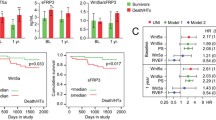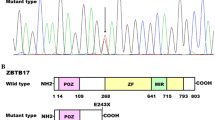Abstract
Dilated cardiomyopathy (DCM) is an important cause of heart failure and sudden cardiac death worldwide. Transcription factor TBX20 has been shown to play a crucial role in cardiac development and maintenance of adult mouse heart. Recent studies suggest that TBX20 may have a role in pathophysiology of DCM. In the present study, we examined TBX20 expression in idiopathic DCM patients and in an animal model of cardiomyopathy, and studied its correlation with echocardiographic indices of LV function. Endomyocardial biopsies (EMBs) from intraventricular septal from the right ventricle region were obtained from idiopathic DCM patients (IDCM, n = 30) and from patients with ventricular septal defect (VSD, n = 14) with normal LVEF who served as controls. An animal model of DCM was developed by right renal artery ligation in Wistar rats. Cardiac TBX20 mRNA levels were measured by real-time PCR in IDCM, controls, and in rats. The role of DNA promoter methylation and copy number variation (CNVs) in regulating TBX20 gene expression was also investigated. Cardiac TBX20 mRNA levels were significantly increased (8.9 fold, p < 0.001) in IDCM patients and in RAL rats as compared to the control group. Cardiac TBX20 expression showed a negative correlation with LVEF (r = −0.71, p < 0.001) and a positive correlation with left ventricular end-systolic volume (r = 0.39, p = 0.038). No significant difference in TBX20 CNVs and promoter methylation was observed between IDCM patients and control group. Our results suggest a potential role of TBX20 in pathophysiology of DCM.




Similar content being viewed by others
References
Maron BJ, Towbin JA, Thiene G et al (2006) Contemporary definitions and classification of the cardiomyopathies an american heart association scientific statement from the council on clinical cardiology, heart failure and transplantation committee; quality of care and outcomes research and functional genomics and translational biology interdisciplinary working groups; and council on epidemiology and prevention. Circulation 113:1807–1816. doi:10.1161/CIRCULATIONAHA.106.174287
Jefferies JL, Towbin JA (2010) Dilated cardiomyopathy. Lancet 375:752–762. doi:10.1016/S0140-6736(09)62023-7
Torrado M, López E, Centeno A et al (2003) Myocardin mRNA is augmented in the failing myocardium: expression profiling in the porcine model and human dilated cardiomyopathy. J Mol Med Berl Ger 81:566–577. doi:10.1007/s00109-003-0470-7
Oka T, Xu J, Molkentin JD (2007) Re-employment of developmental transcription factors in adult heart disease. Semin Cell Dev Biol 18:117–131. doi:10.1016/j.semcdb.2006.11.012
Rajabi M, Kassiotis C, Razeghi P, Taegtmeyer H (2007) Return to the fetal gene program protects the stressed heart: a strong hypothesis. Heart Fail Rev 12:331–343. doi:10.1007/s10741-007-9034-1
Kontaraki JE, Parthenakis FI, Nyktari EG et al (2010) Myocardial gene expression alterations in peripheral blood mononuclear cells of patients with idiopathic dilated cardiomyopathy. Eur J Heart Fail 12:541–548. doi:10.1093/eurjhf/hfq057
Yang J, Moravec CS, Sussman MA et al (2000) Decreased SLIM1 expression and increased gelsolin expression in failing human hearts measured by high-density oligonucleotide arrays. Circulation 102:3046–3052. doi:10.1161/01.CIR.102.25.3046
Plageman TF, Yutzey KE (2004) Differential expression and function of Tbx5 and Tbx20 in cardiac development. J Biol Chem 279:19026–19034. doi:10.1074/jbc.M314041200
Shen T, Aneas I, Sakabe N et al (2011) Tbx20 regulates a genetic program essential to adult mouse cardiomyocyte function. J Clin Invest 121:4640–4654. doi:10.1172/JCI59472
Brown DD, Martz SN, Binder O et al (2005) Tbx5 and Tbx20 act synergistically to control vertebrate heart morphogenesis. Dev Camb Engl 132:553–563. doi:10.1242/dev.01596
Stennard FA, Costa MW, Elliott DA et al (2003) Cardiac T-box factor Tbx20 directly interacts with Nk2–5, GATA4, and GATA5 in regulation of gene expression in the developing heart. Dev Biol 262:206–224
Qian L, Mohapatra B, Akasaka T et al (2008) Transcription factor neuromancer/TBX20 is required for cardiac function in Drosophila with implications for human heart disease. Proc Natl Acad Sci U S A 105:19833–19838. doi:10.1073/pnas.0808705105
Hammer S, Toenjes M, Lange M et al (2008) Characterization of TBX20 in human hearts and its regulation by TFAP2. J Cell Biochem 104:1022–1033. doi:10.1002/jcb.21686
Kirk EP, Sunde M, Costa MW et al (2007) Mutations in cardiac T-box factor gene TBX20 are associated with diverse cardiac pathologies, including defects of septation and valvulogenesis and cardiomyopathy. Am J Hum Genet 81:280–291. doi:10.1086/519530
Mir SA, Chatterjee A, Mitra A et al (2012) Inhibition of signal transducer and activator of transcription 3 (STAT3) attenuates interleukin-6 (IL-6)-induced collagen synthesis and resultant hypertrophy in rat heart. J Biol Chem 287:2666–2677. doi:10.1074/jbc.M111.246173
Database of genomic variants. http://dgv.tcag.ca/dgv/app/variant?ref=GRCh37/hg19&id=dgv1280e214. Accessed 25 Sep 2015
Chakraborty S, Sengupta A, Yutzey KE (2013) Tbx20 promotes cardiomyocyte proliferation and persistence of fetal characteristics in adult mouse hearts. J Mol Cell Cardiol 62:203–213. doi:10.1016/j.yjmcc.2013.05.018
Cai C-L, Zhou W, Yang L et al (2005) T-box genes coordinate regional rates of proliferation and regional specification during cardiogenesis. Dev Camb Engl 132:2475–2487. doi:10.1242/dev.01832
Chakraborty S, Yutzey KE (2012) Tbx20 regulation of cardiac cell proliferation and lineage specialization during embryonic and fetal development in vivo. Dev Biol 363:234–246. doi:10.1016/j.ydbio.2011.12.034
Zhang W, Chen H, Wang Y et al (2011) Tbx20 transcription factor is a downstream mediator for bone morphogenetic protein-10 in regulating cardiac ventricular wall development and function. J Biol Chem 286:36820–36829. doi:10.1074/jbc.M111.279679
Vasan RS, Larson S, Martin G, Benjamin EJ et al (1999) Congestive heart failure in subjects with normal versus reduced left ventricular ejection fraction: prevalence and mortality in a population-based cohort. J Am Coll Cardiol 33:1948–1955. doi:10.1016/S0735-1097(99)00118-7
Meinertz T, Hofmann T, Kasper W et al (1984) Significance of ventricular arrhythmias in idiopathic dilated cardiomyopathy. Am J Cardiol 53:902–907. doi:10.1016/0002-9149(84)90522-8
Sheng W, Wang H, Ma X et al (2012) LINE-1 methylation status and its association with tetralogy of fallot in infants. BMC Med Gen 5:20. doi:10.1186/1755-8794-5-20
Redon R, Ishikawa S, Fitch KR et al (2006) Global variation in copy number in the human genome. Nature 444:444–454. doi:10.1038/nature05329
McCarroll SA, Altshuler DM (2007) Copy-number variation and association studies of human disease. Nat Genet 39:S37–S42. doi:10.1038/ng2080
Fakhro KA, Choi M, Ware SM et al (2011) Rare copy number variations in congenital heart disease patients identify unique genes in left-right patterning. Proc Natl Acad Sci 108:2915–2920. doi:10.1073/pnas.1019645108
Ikeda S, Kong SW, Lu J et al (2007) Altered microRNA expression in human heart disease. Physiol Gen 31:367–373. doi:10.1152/physiolgenomics.00144.2007
Thum T, Gross C, Fiedler J et al (2008) MicroRNA-21 contributes to myocardial disease by stimulating MAP kinase signalling in fibroblasts. Nature 456:980–984. doi:10.1038/nature07511
Sayed D, Hong C, Chen I-Y et al (2007) MicroRNAs play an essential role in the development of cardiac hypertrophy. Circ Res 100:416–424. doi:10.1161/01.RES.0000257913.42552.23
Urbich C, Kuehbacher A, Dimmeler S (2008) Role of microRNAs in vascular diseases, inflammation, and angiogenesis. Cardiovasc Res 79:581–588. doi:10.1093/cvr/cvn156
Acknowledgments
We would like to acknowledge all the faculties of the Department of Cardiothoracic and Vascular Surgery, PGIMER, especially Dr. Shyam K Thignum, for providing us the control heart tissues.
Funding source
Anupam Mittal was supported by Indian Council of Medical Education and Research (3/1/2(4)/CVD/2011/NCD-II), New Delhi, India. This work was supported by an intramural Grant from Postgraduate Institute of Medical Education and Research, Chandigarh.
Author information
Authors and Affiliations
Corresponding author
Ethics declarations
Conflict of interest
Authors declare no conflict of interest.
Human studies declaration
All procedures followed were in accordance with the ethical standards of the Institutional Ethics committee on human experimentation and with the Helsinki Declaration of 1975, as revised in 2000. Informed consent was obtained from all patients for being included in the study.
Rights and permissions
About this article
Cite this article
Mittal, A., Sharma, R., Prasad, R. et al. Role of cardiac TBX20 in dilated cardiomyopathy. Mol Cell Biochem 414, 129–136 (2016). https://doi.org/10.1007/s11010-016-2666-5
Received:
Accepted:
Published:
Issue Date:
DOI: https://doi.org/10.1007/s11010-016-2666-5




